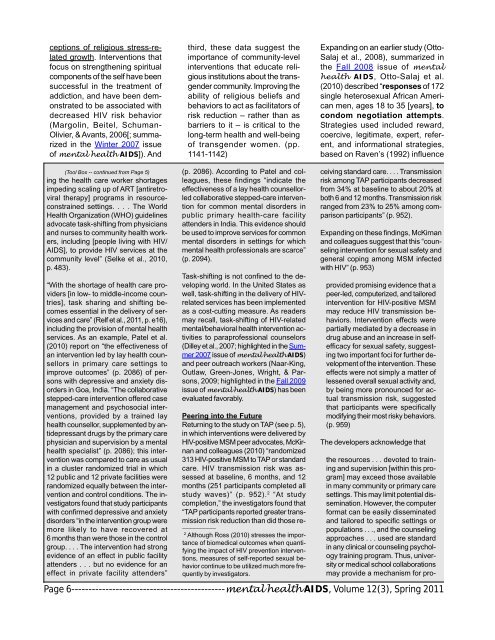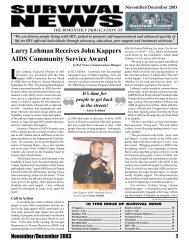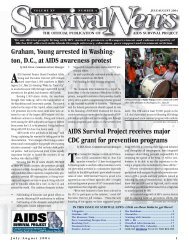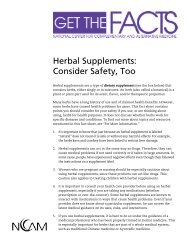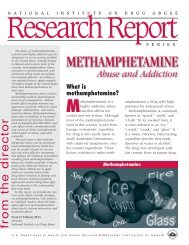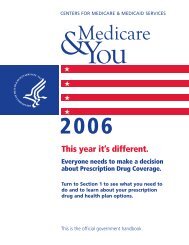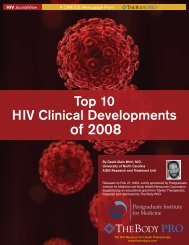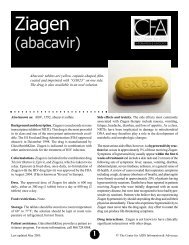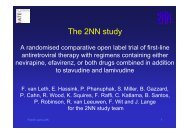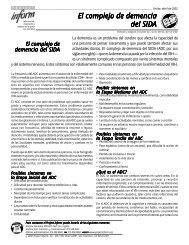Mental Health Aids. Spring 2011. - Substance Abuse and Mental ...
Mental Health Aids. Spring 2011. - Substance Abuse and Mental ...
Mental Health Aids. Spring 2011. - Substance Abuse and Mental ...
Create successful ePaper yourself
Turn your PDF publications into a flip-book with our unique Google optimized e-Paper software.
ceptions of religious stress-related<br />
growth. Interventions that<br />
focus on strengthening spiritual<br />
components of the self have been<br />
successful in the treatment of<br />
addiction, <strong>and</strong> have been demonstrated<br />
to be associated with<br />
decreased HIV risk behavior<br />
(Margolin, Beitel, Schuman-<br />
Olivier, & Avants, 2006[; summarized<br />
in the Winter 2007 issue<br />
of mental health AIDS]). And<br />
(Tool Box -- continued from Page 5)<br />
ing the health care worker shortages<br />
impeding scaling up of ART [antiretroviral<br />
therapy] programs in resourceconstrained<br />
settings. . . . The World<br />
<strong>Health</strong> Organization (WHO) guidelines<br />
advocate task-shifting from physicians<br />
<strong>and</strong> nurses to community health workers,<br />
including [people living with HIV/<br />
AIDS], to provide HIV services at the<br />
community level” (Selke et al., 2010,<br />
p. 483).<br />
“With the shortage of health care providers<br />
[in low- to middle-income countries],<br />
task sharing <strong>and</strong> shifting becomes<br />
essential in the delivery of services<br />
<strong>and</strong> care” (Relf et al., 2011, p. e16),<br />
including the provision of mental health<br />
services. As an example, Patel et al.<br />
(2010) report on “the effectiveness of<br />
an intervention led by lay health counsellors<br />
in primary care settings to<br />
improve outcomes” (p. 2086) of persons<br />
with depressive <strong>and</strong> anxiety disorders<br />
in Goa, India. “The collaborative<br />
stepped-care intervention offered case<br />
management <strong>and</strong> psychosocial interventions,<br />
provided by a trained lay<br />
health counsellor, supplemented by antidepressant<br />
drugs by the primary care<br />
physician <strong>and</strong> supervision by a mental<br />
health specialist” (p. 2086); this intervention<br />
was compared to care as usual<br />
in a cluster r<strong>and</strong>omized trial in which<br />
12 public <strong>and</strong> 12 private facilities were<br />
r<strong>and</strong>omized equally between the intervention<br />
<strong>and</strong> control conditions. The investigators<br />
found that study participants<br />
with confirmed depressive <strong>and</strong> anxiety<br />
disorders “in the intervention group were<br />
more likely to have recovered at<br />
6 months than were those in the control<br />
group. . . . The intervention had strong<br />
evidence of an effect in public facility<br />
attenders . . . but no evidence for an<br />
effect in private facility attenders”<br />
third, these data suggest the<br />
importance of community-level<br />
interventions that educate religious<br />
institutions about the transgender<br />
community. Improving the<br />
ability of religious beliefs <strong>and</strong><br />
behaviors to act as facilitators of<br />
risk reduction – rather than as<br />
barriers to it – is critical to the<br />
long-term health <strong>and</strong> well-being<br />
of transgender women. (pp.<br />
1141-1142)<br />
(p. 2086). According to Patel <strong>and</strong> colleagues,<br />
these findings “indicate the<br />
effectiveness of a lay health counsellorled<br />
collaborative stepped-care intervention<br />
for common mental disorders in<br />
public primary health-care facility<br />
attenders in India. This evidence should<br />
be used to improve services for common<br />
mental disorders in settings for which<br />
mental health professionals are scarce”<br />
(p. 2094).<br />
Task-shifting is not confined to the developing<br />
world. In the United States as<br />
well, task-shifting in the delivery of HIVrelated<br />
services has been implemented<br />
as a cost-cutting measure. As readers<br />
may recall, task-shifting of HIV-related<br />
mental/behavioral health intervention activities<br />
to paraprofessional counselors<br />
(Dilley et al., 2007; highlighted in the Summer<br />
2007 issue of mental health AIDS)<br />
<strong>and</strong> peer outreach workers (Naar-King,<br />
Outlaw, Green-Jones, Wright, & Parsons,<br />
2009; highlighted in the Fall 2009<br />
issue of mental health AIDS) has been<br />
evaluated favorably.<br />
Peering into the Future<br />
Returning to the study on TAP (see p. 5),<br />
in which interventions were delivered by<br />
HIV-positive MSM peer advocates, McKirnan<br />
<strong>and</strong> colleagues (2010) “r<strong>and</strong>omized<br />
313 HIV-positive MSM to TAP or st<strong>and</strong>ard<br />
care. HIV transmission risk was assessed<br />
at baseline, 6 months, <strong>and</strong> 12<br />
months (251 participants completed all<br />
study waves)” (p. 952).<br />
__________<br />
2<br />
2 “At study<br />
completion,” the investigators found that<br />
“TAP participants reported greater transmission<br />
risk reduction than did those re-<br />
Although Ross (2010) stresses the importance<br />
of biomedical outcomes when quantifying<br />
the impact of HIV prevention interventions,<br />
measures of self-reported sexual behavior<br />
continue to be utilized much more frequently<br />
by investigators.<br />
Exp<strong>and</strong>ing on an earlier study (Otto-<br />
Salaj et al., 2008), summarized in<br />
the Fall 2008 issue of mental<br />
health AIDS, Otto-Salaj et al.<br />
(2010) described “responses of 172<br />
single heterosexual African American<br />
men, ages 18 to 35 [years], to<br />
condom negotiation attempts.<br />
Strategies used included reward,<br />
coercive, legitimate, expert, referent,<br />
<strong>and</strong> informational strategies,<br />
based on Raven’s (1992) influence<br />
ceiving st<strong>and</strong>ard care. . . . Transmission<br />
risk among TAP participants decreased<br />
from 34% at baseline to about 20% at<br />
both 6 <strong>and</strong> 12 months. Transmission risk<br />
ranged from 23% to 25% among comparison<br />
participants” (p. 952).<br />
Exp<strong>and</strong>ing on these findings, McKirnan<br />
<strong>and</strong> colleagues suggest that this “counseling<br />
intervention for sexual safety <strong>and</strong><br />
general coping among MSM infected<br />
with HIV” (p. 953)<br />
provided promising evidence that a<br />
peer-led, computerized, <strong>and</strong> tailored<br />
intervention for HIV-positive MSM<br />
may reduce HIV transmission behaviors.<br />
Intervention effects were<br />
partially mediated by a decrease in<br />
drug abuse <strong>and</strong> an increase in selfefficacy<br />
for sexual safety, suggesting<br />
two important foci for further development<br />
of the intervention. These<br />
effects were not simply a matter of<br />
lessened overall sexual activity <strong>and</strong>,<br />
by being more pronounced for actual<br />
transmission risk, suggested<br />
that participants were specifically<br />
modifying their most risky behaviors.<br />
(p. 959)<br />
The developers acknowledge that<br />
the resources . . . devoted to training<br />
<strong>and</strong> supervision [within this program]<br />
may exceed those available<br />
in many community or primary care<br />
settings. This may limit potential dissemination.<br />
However, the computer<br />
format can be easily disseminated<br />
<strong>and</strong> tailored to specific settings or<br />
populations . . ., <strong>and</strong> the counseling<br />
approaches . . . used are st<strong>and</strong>ard<br />
in any clinical or counseling psychology<br />
training program. Thus, university<br />
or medical school collaborations<br />
may provide a mechanism for pro-<br />
Page 6---------------------------------------------mental health AIDS, Volume 12(3), <strong>Spring</strong> 2011


